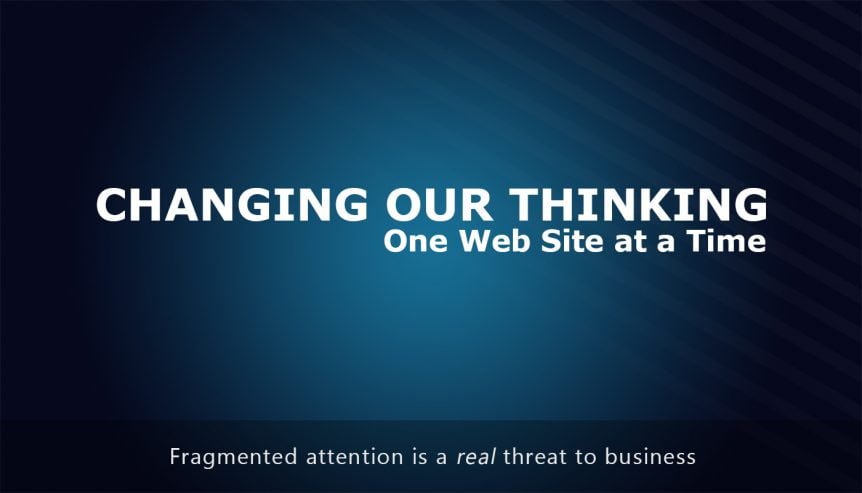There is a growing concern permeating across many different fields in our Internet-driven society: that the attention spans among Internet users are becoming increasingly fragmented. Gaining more than a few seconds of attention from today’s Internet information consumers has become such an obstacle for content providers that many designers and marketers, as well as professionals from other information technology-driven industries, are beginning to feel the gravity of the situation. To quote a phrase by Aesop, a famous Greek poet (c. 500 BC), “We would often be sorry if our wishes were gratified” (Tobak). This attention fragmentation phenomenon is a consequence of our own technological success, and is a result of consumers dealing with information overload. However, not all hope is lost; Web designers can champion an enlightened way of thinking by understanding a vital misconception, and taking action.
When I first dove into the processes of reaching an Internet audience back in the early 90s, there were not many Web and information design rules or theories in place. Even when only equipped with the most basic of design skills and a little bit of technical knowledge, any Web site had the potential to attract and retain focused attention. The Internet was new; people were hungry for new experiences and eager to explore previously distant information. Life as a Web designer back then was relatively simple.
Those days of simple Web design are long gone… and thankfully so, I might add. Since the Internet became increasingly accessible to more individuals, content providers, businesses, and opportunists alike, the Internet has – not so gradually – become a perfect storm of organized and disorganized information. An article from 1999 on the growth of the World Wide Web, released only eight years after the introduction of the public Internet, stated, “the World-Wide Web has transformed into an ecology of knowledge in which highly diverse information is linked in an extremely complex and arbitrary manner” (Huberman and Adamic). At that time, there were only around 11,000,000 Web sites on the Internet. In retrospect, as of March, 2014, there were over 193,000,000 active Web sites reported and over 643,000,000 hostnames in use, both still growing at an alarming rate (Netcraft). This information highlights the increasing complexities of exponentially compounding “highly diverse” information.
There is so much new information flooding onto the Internet each day that our cognitive processes of evaluating and reducing information needs some external assistance. At the time of writing this, Google.com is the number one most visited Web site in the world (Alexa). This not-so-surprising statistic exemplifies that, above all else, our minds cannot store and sort through the proverbial universe of information available on the Internet without help.
The human mind may very well be an amazing piece of biological machinery, but even in all of its wonder, it has its limitations. In a popular research article written by George A. Miller, an experimental psychologist and pioneer in cognitive psychology (Vitello), the author suggested that the mind could only accurately manage an average of seven thoughts in its working memory at a time, “. . . Seven, plus or minus two” (Miller). The significance of this research is that it offers insight into why people are mentally incapable of dealing with large amounts of information at once, even if they wish to.
In a practical sense, it can be challenging to wrap our heads around how so much information on the Internet has changed our attention today. In an article by David Glen, a senior reporter at The Chronicle, Washington, D.C., there were connections made between psychological research and the human capacity to process information. In this article, the author provides insight through associations in cognitive capacity and its manifested consequences.
Imagine that driving across town, you’ve fallen into a reverie, meditating on lost loves or calculating your next tax payments. You’re so distracted that you rear-end the car in front of you at 10 miles an hour. You probably think: Damn. My fault. My mind just wasn’t there.David Glenn
The significance of this scenario is that it explains, in relatable terms, how our minds reach a limit of processing capacity in everyday life, in addition to the resulting consequences. The mind subconsciously prescreens information, ignoring much of what it believes is unimportant to its current tasks. This process of information deflection creates a state of what we might call uncontrolled attention as opposed to what we, as Web designers strive for: the focused and controlled attention of our audience.
A commonly used metaphor when discussing controlled attention is that it “acts as a nightclub bouncer, preventing irrelevant stuff from getting into working memory” (Glenn). To make further use of this metaphor, I suggest that because we only have a limited amount of space available in our nightclub – our working memory – and there are all types of people storming the doors – lots of information – we have our bouncers prescreen them. We have given the bouncers our criteria and we anticipate that they will do a good job. However, because we are not standing right next to them the entire time – always in conscious and focused attention control – we have to trust that they will make the right decisions, mostly unsupervised. We understand that some undesirables may slip through – we get sidetracked – and some desirables may be turned away – we miss an opportunity – but we need them there to act as a filter; if they did not, there is no way we could handle the onslaught of the crowd.
Over the past twenty-five years as an interactive media designer and nine years as a creative director, I have often been tasked with the job of designing user interfaces; not just within the realm of desktop applications or other holistically delivered solutions, but also within the agile environment of Web site designs. This task often includes several design and technology-based building blocks, such as target audience evaluation and technology assessments, but the end goal always remains the same: choose the best possible methods to represent the information for human engagement and consumption; ergo, reach the audience.
It has become common knowledge among designers that a Web site has about ten seconds to engage a user; if it does not, the user leaves. This information is based on sound research, such as that of Chao Liu and associates from Microsoft Research in 2010 (Liu, White and Dumais). Considering the ten-second rule and examining why a user might not stay beyond that duration, the assessment can become quite a riddle: oversaturated market, inappropriate media buying, poor campaign strategy, unrealistic business model, bad Web design, or a mountain of other reasons. Although any combination of these causes can most certainly be a contributing factor, my experience tells me that this assessment tends to take on an almost programmatic methodology, a method that places little consideration on a user’s repetitiously trained cognitive responses to an overwhelming amount of information.
We, as information architects, literally overlook the trees for the forest; we forget how the exposure to vast amounts of information, has essentially trained Internet information consumers to make increasingly quick and sometimes irrational decisions about information. While there have been some efforts to counteract this behavior, like cleaner designs and better content keywords, we still have a ways to go. On the bright side, however, the first step to recovery is acknowledging that we have a problem; and attention fragmentation is our intervention.
I understand now, only after years of experience and some recent research, that we have failed to fully realize the changes that the wealth of information on the Internet has introduced into the human cognitive processes. At some point, we overlooked a consumer decision influence that goes beyond color, typography, and information design theories. The missing piece is the epiphany of how the exposure to such diverse information has influenced the attention of Internet users.
Web designers, as intermediary performance analysts and solution providers, often take for granted that within an average of ten seconds the user would logically evaluate the webpage’s real content. With all of the Web site performance reports we tend to use, like server logs, statistics, and analytics, to name a few, it only makes sense that we tend to overlook cognitive changes in light of statistical performance trends. I certainly do not recall a time when digging through server logs that I came across a sociological and cognitive psychology update report; unless I was so busy, I overlooked it. With all of this enticing data readily available, it is easy to assume that the user is making predictable and measurable decisions: decisions as to whether or not the content meets their needs. This is, most fundamentally, an assumption that we can no longer afford to accommodate.
Moreover, this is precisely the misconception that hints at how we can work with this attention fragmentation phenomenon. We can take the initiative by:
- taking it upon ourselves to rethink those growingly important keywords and avoid vague or misleading references
- relocating advertisements to less distracting locations
- discouraging the use of pop-up and pop-under ads
- ensuring that we put relevant information front and center
- encouraging each of our Web design clients to engage in more intuitive and meaningful conversations with their audiences
- continuing to do this for all of our clients
We possess the capabilities to tame this growing attention concern by taking actions that will make a difference.
Attention fragmentation among Internet users is a manifested cognitive byproduct of the exponential growth in diverse information. While it may be true that the mind is amazing at working with complex information, it is not without its limitations. As Web designers, it can be easy to overlook cognitive changes in our target audience for readily available reports and typical assessment methods; however, we can no longer afford to rely on those methods alone. It is time for this attention fragmentation phenomenon, which has primarily existed outside of our normal line of questioning in design and performance assessment, to become an important part of our processes. It is more imperative than ever before, that we enlighten our clients and ourselves to the drivers of this issue. This is our opportunity, as Web designers, marketers, and professionals of a technology-driven industry, to make the Internet a more intuitive and attention focused place for everyone, one Web site at a time.
Share this Post
Works Cited
Alexa. “Alexa Top 500 Global Sites.” 18 Mar. 2014. alexa.com. Web. 18 Mar. 2014.
Glenn, David. “The Chronicle Review.” 28 Feb. 2010. The Chronicle of Higher Education. Web. 17 Mar. 2014.
Huberman, Bernardo A. and Lada A. Adamic. “Growth dynamics of the World Wide Web.” Nature 9 Sept. 1999: 131. Print.
Liu, Chao, Ryen W. White and Susan Dumais. “Understanding web browsing behaviors through Weibull analysis of dwell time.” SIGIR ’10 Proceedings of the 33rd international ACM SIGIR conference on Research and development in informational retrieval. New York: ACM, 2010. 379-386. Print.
Miller, George A. “The Magical Number Seven, Plus or Minus Two.” The Psycholological Review 63.2 (1956): 81-97. Print.
Netcraft. “March 2012 Web Server Survey.” Mar. 2012. netcraft.com. Web. 18 Mar. 2014.
Tobak, Steve. “Be Cearful What You Wish For.” 1 Apr. 2011. cbsnews.com. Web. 18 Mar. 2014.
Vitello, Paul. “George A. Miller, Cognitve Psychology Pioneer, Dies at 92.” 1 Aug. 2012. nytimes.com. Web. 22 March 2014.
Special Thanks
Kate Butler and the Art Institute for inspiring this article.

